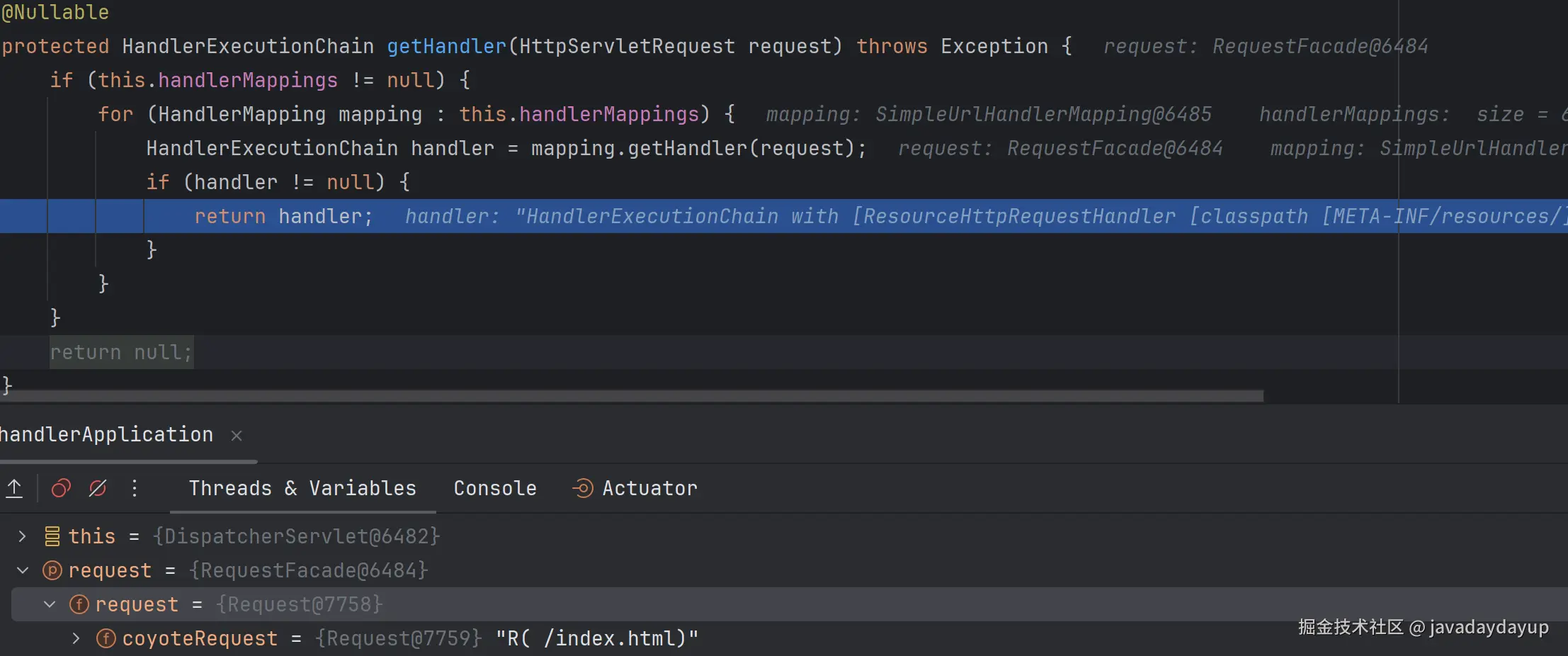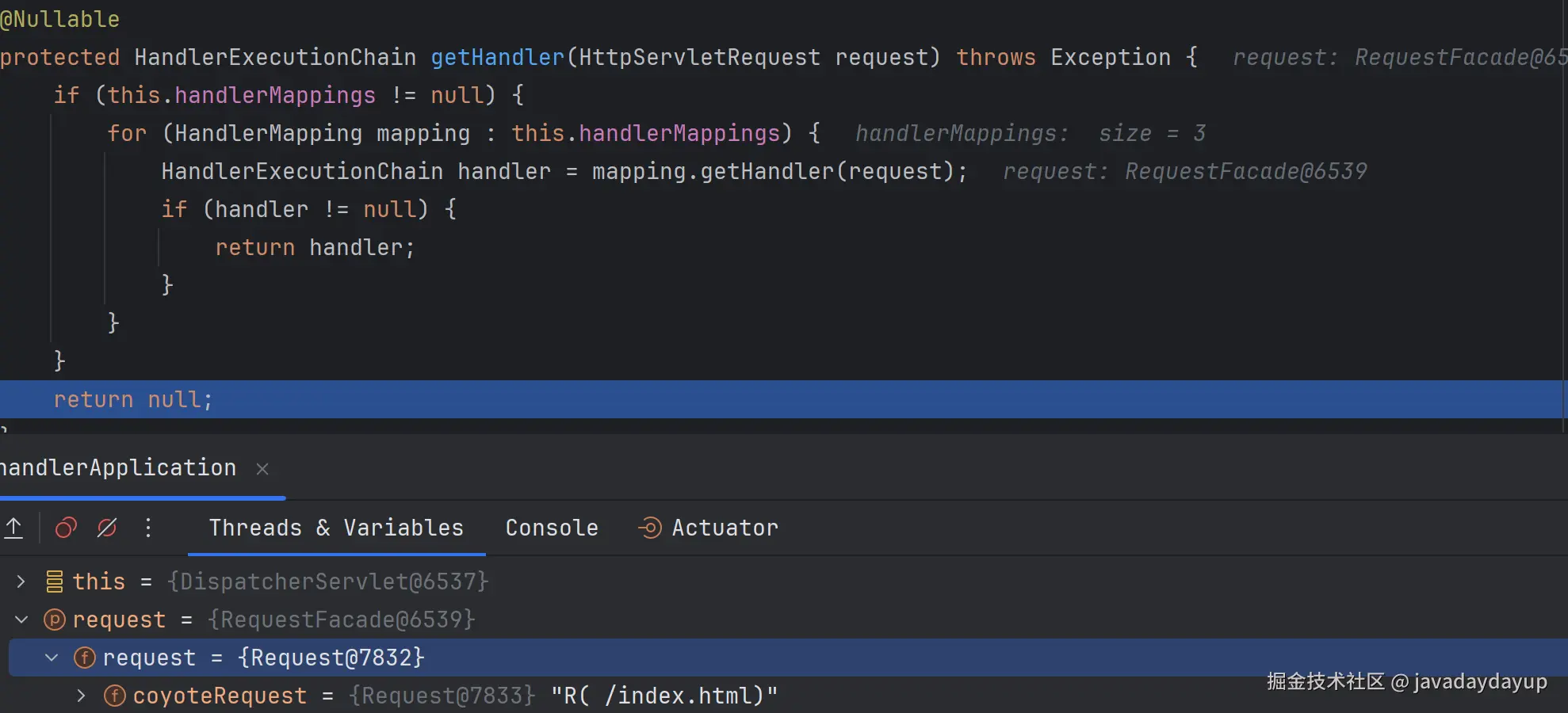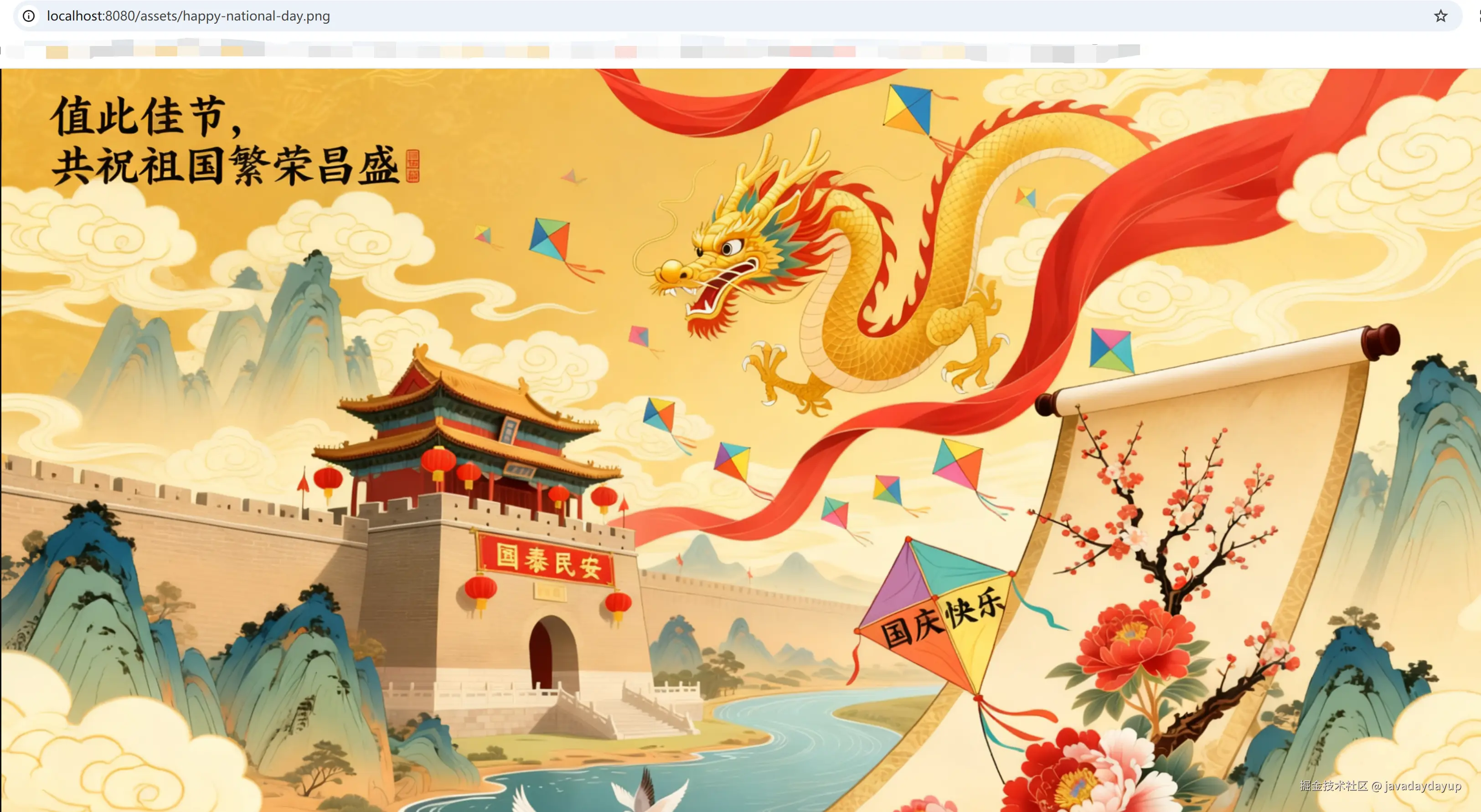问题现象
在一个业务中引入了一个基于 Spring Quartz 二次开发的定时任务框架,这个任务框架自己提供了一个管理界面,但是微服务启动之后却访问不了它的管理界面,提示 404。按照 Spring Boot 的说法应该是会注册一个默认的静态资源处理器的,但是实际调试发现并没有注册任何的静态资源处理器,从而导致了无法访问静态资源。导致没有注册静态资源处理器的原因是项目中提供了一个继承了 WebMvcConfigurationSupport 的配置类。现象如下图所示: 
问题复现
自己构造一个测试的 Demo 项目结构,在 resources 下面有 META-INF/resources 目录,在这个目录下有一个 index.html 文件。如下图所示: 
启动应用之后,通过 http://localhost:8080/index.html 可以访问到这个界面。如下图所示:  通过调试
通过调试 DispatcherServlet 的 getHanlder() 方法可以看到找到一个 ResourceHttpRequestHandler,说明找到了一个默认的静态资源处理器。如下图所示: 
当增加一个继承了 WebMvcConfigurationSupport 的配置类 TestConfig 时,再访问 http://localhost:8080/index.html 这个地址时,就提示 404 了。如下图所示: 

通过调试 DispatcherServlet 的 getHanlder() 方法可以看到找不到对应的 Handler,说明确实没有注册静态资源的处理器。 
那为什么增加一个继承了 WebMvcConfigurationSupport 的配置类 TestConfig 时,默认的静态资源处理器就不注册了呢?接下来将从源码的角度进行分析。
源码分析
在前面的文章Spring把「手动」的复杂裹成了「自动」的温柔中分析了 Spring Boot 自动配置 Spring MVC 的配置类 WebMvcAutoConfiguration,它初始化的条件是 CLASSPATH 路径下存在存在 Servlet, DispatcherServlet, WebMvcConfigurer 这些类,同时没有配置 WebMvcConfigurationSupport 类型的 Bean。
而上面的案例中恰好是提供了一个继承了 WebMvcConfigurationSupport 的配置类 TestConfig,所以 @ConditionalOnMissingBean(WebMvcConfigurationSupport.class) 这个条件则不满足,则配置类 WebMvcAutoConfiguration 则不会起作用。静态资源处理器的注册恰恰就是在 WebMvcAutoConfiguration 配置类中注册的。代码如下:
java
@AutoConfiguration(after = { DispatcherServletAutoConfiguration.class, TaskExecutionAutoConfiguration.class,
ValidationAutoConfiguration.class })
@ConditionalOnWebApplication(type = Type.SERVLET)
@ConditionalOnClass({ Servlet.class, DispatcherServlet.class, WebMvcConfigurer.class })
@ConditionalOnMissingBean(WebMvcConfigurationSupport.class)
@AutoConfigureOrder(Ordered.HIGHEST_PRECEDENCE + 10)
@ImportRuntimeHints(WebResourcesRuntimeHints.class)
public class WebMvcAutoConfiguration {
}那 WebMvcAutoConfiguration 配置类是如何注册静态资源处理器的呢?在 WebMvcAutoConfiguration 中有一个静态内部类 WebMvcAutoConfigurationAdapter,在它的 addResourceHandlers() 方法里面就是负责默认静态资源的处理器。
而这静态资源处理器默认能够处理的静态资源路径是通过 this.resourceProperties.getStaticLocations() 方法返回的,而这个 this.resourceProperties 的赋值是通过 WebProperties 的 getResources() 方法赋值的。代码如下:
java
@Configuration(proxyBeanMethods = false)
@Import(EnableWebMvcConfiguration.class)
@EnableConfigurationProperties({ WebMvcProperties.class, WebProperties.class })
@Order(0)
public static class WebMvcAutoConfigurationAdapter implements WebMvcConfigurer, ServletContextAware {
private final Resources resourceProperties;
private final WebMvcProperties mvcProperties;
public WebMvcAutoConfigurationAdapter(WebProperties webProperties, WebMvcProperties mvcProperties,
ListableBeanFactory beanFactory, ObjectProvider<HttpMessageConverters> messageConvertersProvider,
ObjectProvider<ResourceHandlerRegistrationCustomizer> resourceHandlerRegistrationCustomizerProvider,
ObjectProvider<DispatcherServletPath> dispatcherServletPath,
ObjectProvider<ServletRegistrationBean<?>> servletRegistrations) {
// 在这里给resourceProperties赋值的
this.resourceProperties = webProperties.getResources();
this.mvcProperties = mvcProperties;
this.beanFactory = beanFactory;
this.messageConvertersProvider = messageConvertersProvider;
this.resourceHandlerRegistrationCustomizer = resourceHandlerRegistrationCustomizerProvider.getIfAvailable();
this.dispatcherServletPath = dispatcherServletPath;
this.servletRegistrations = servletRegistrations;
}
@Override
public void addResourceHandlers(ResourceHandlerRegistry registry) {
if (!this.resourceProperties.isAddMappings()) {
logger.debug("Default resource handling disabled");
return;
}
addResourceHandler(registry, this.mvcProperties.getWebjarsPathPattern(),
"classpath:/META-INF/resources/webjars/");
// 这里注册静态资源处理器
addResourceHandler(registry, this.mvcProperties.getStaticPathPattern(), (registration) -> {
registration.addResourceLocations(this.resourceProperties.getStaticLocations()); // 这个Lambda表达式注册了静态资源处理器默认处理的资源路径
if (this.servletContext != null) {
ServletContextResource resource = new ServletContextResource(this.servletContext, SERVLET_LOCATION);
registration.addResourceLocations(resource);
}
});
}
private void addResourceHandler(ResourceHandlerRegistry registry, String pattern,
Consumer<ResourceHandlerRegistration> customizer) {
if (registry.hasMappingForPattern(pattern)) {
return;
}
ResourceHandlerRegistration registration = registry.addResourceHandler(pattern);
customizer.accept(registration);
registration.setCachePeriod(getSeconds(this.resourceProperties.getCache().getPeriod()));
registration.setCacheControl(this.resourceProperties.getCache().getCachecontrol().toHttpCacheControl());
registration.setUseLastModified(this.resourceProperties.getCache().isUseLastModified());
customizeResourceHandlerRegistration(registration);
}
}在 WebProperties 类中有一个静态内部类 Resources,它里面的 CLASSPATH_RESOURCE_LOCATIONS 静态变量定义了静态资源处理器默认处理的路径。 前面的this.resourceProperties.getStaticLocations() 方法返回的值就是这个静态变量的值。代码如下:
java
ConfigurationProperties("spring.web")
public class WebProperties {
/**
* Locale to use. By default, this locale is overridden by the "Accept-Language"
* header.
*/
private Locale locale;
/**
* Define how the locale should be resolved.
*/
private LocaleResolver localeResolver = LocaleResolver.ACCEPT_HEADER;
private final Resources resources = new Resources();
public static class Resources {
private static final String[] CLASSPATH_RESOURCE_LOCATIONS = { "classpath:/META-INF/resources/",
"classpath:/resources/", "classpath:/static/", "classpath:/public/" };
/**
* Locations of static resources. Defaults to classpath:[/META-INF/resources/,
* /resources/, /static/, /public/].
*/
private String[] staticLocations = CLASSPATH_RESOURCE_LOCATIONS;
public String[] getStaticLocations() {
return this.staticLocations;
}
}
}在 WebMvcAutoConfiguration 还有一个内部类 EnableWebMvcConfiguration,它本身也是一个 Bean,在它的父类 DelegatingWebMvcConfiguration 的 setConfigurers() 方法会注入所有实现了 WebMvcConfigurer 接口的 Bean。Spring 中注入实现了一个接口的所有 Bean 的原理可以看前面的文章 别再逐个注入了!@Autowired 批量获取接口实现类的核心逻辑拆解。
而上面的 WebMvcAutoConfigurationAdapter 恰好就是一个实现了 WebMvcConfigurer 接口的 Bean。在 DelegatingWebMvcConfiguration 的 addResourceHandlers() 方法中会调用所有实现了 WebMvcConfigurer 接口的 Bean 的 addResourceHandlers() 方法。代码如下:
java
@Configuration(proxyBeanMethods = false)
public class DelegatingWebMvcConfiguration extends WebMvcConfigurationSupport {
private final WebMvcConfigurerComposite configurers = new WebMvcConfigurerComposite();
@Autowired(required = false)
public void setConfigurers(List<WebMvcConfigurer> configurers) {
if (!CollectionUtils.isEmpty(configurers)) {
this.configurers.addWebMvcConfigurers(configurers);
}
}
@Override
protected void addResourceHandlers(ResourceHandlerRegistry registry) {
this.configurers.addResourceHandlers(registry);
}
}而 DelegatingWebMvcConfiguration 的 addResourceHandlers() 是在它的父类 WebMvcConfigurationSupport 的 resourceHandlerMapping() 方法中调用的,这个方法本质上是在初始化一个 HandlerMapping 的 Bean。代码如下:
java
public class WebMvcConfigurationSupport implements ApplicationContextAware, ServletContextAware {
@Bean
@Nullable
public HandlerMapping resourceHandlerMapping(
@Qualifier("mvcContentNegotiationManager") ContentNegotiationManager contentNegotiationManager,
@Qualifier("mvcConversionService") FormattingConversionService conversionService,
@Qualifier("mvcResourceUrlProvider") ResourceUrlProvider resourceUrlProvider) {
Assert.state(this.applicationContext != null, "No ApplicationContext set");
Assert.state(this.servletContext != null, "No ServletContext set");
PathMatchConfigurer pathConfig = getPathMatchConfigurer();
ResourceHandlerRegistry registry = new ResourceHandlerRegistry(this.applicationContext,
this.servletContext, contentNegotiationManager, pathConfig.getUrlPathHelper());
// 这里调用了addResourceHandlers()方法
addResourceHandlers(registry);
AbstractHandlerMapping mapping = registry.getHandlerMapping();
initHandlerMapping(mapping, conversionService, resourceUrlProvider);
return mapping;
}
}后续
既然提供了一个继承了 WebMvcConfigurationSupport 的配置类就会导致默认的静态资源处理器失效,那假如项目就是想自定义静态资源器处理的资源路径,这个应该怎么实现呢?
其实答案就藏在上面的 DelegatingWebMvcConfiguration 的 setConfigurers() 方法中。这个方法会注入所有实现了 WebMvcConfigurer 接口的 Bean,然后在它的 addResourceHandlers() 方法中会调用所有实现了 WebMvcConfigurer 接口的 Bean 的 addResourceHandlers() 方法。
那可以提供一个实现了 WebMvcConfigurer 接口的配置类,在它的 addResourceHandlers() 方法中注册一个自定义的静态资源处理器就可以了。比如下面的代码就将请求的 /assets URL 映射到了 CLASSPATH 下的 my-assets 路径下。代码如下:
java
@Configuration
public class MyWebMvcConfigurer implements WebMvcConfigurer {
@Override
public void addResourceHandlers(ResourceHandlerRegistry registry) {
// 将 /assets/** 的请求映射到 classpath:/my-assets/ 目录下
registry.addResourceHandler("/assets/**")
.addResourceLocations("classpath:/my-assets/");
}
}
